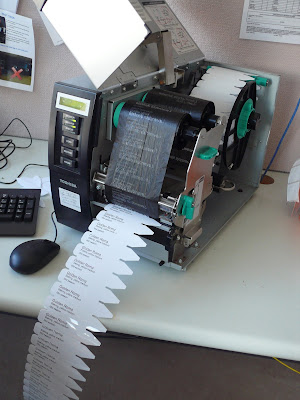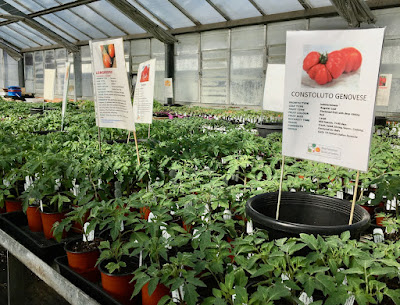Every year the Royal Tasmanian Botanical Gardens (RTBG) in Hobart produces quality heirloom tomato seedlings on a semi-industrial scale for its annual sale in October. This year I joined nursery-horticulturist Margot White and an amazing team of volunteers, and found out how this is done, and what home gardeners can learn from this process.
 |
| Caring for 8000+ tomato seedlings in the lead to the sale |
In this article we are first going to look at what materials are used and how they are used: trays and pots, seeds, soil and labels. Then we will look at the process from seed to ready-for-sale seedling.
Seed trays and pots
For the 2021 tomato seedling sale volunteers, guided by volunteer manager Margot White, started sowing tomato seeds on the 3rd of August. Tomato seeds were sown one or two seeds per cell in seedling plug trays (top tray in photo below) that had a sturdier plastic tray (bottom tray in photo below) under them.
Weeks later, when seedlings had grown to a good size, they were transplanted into individual pots.
The thousands of pots and trays that are needed for this sale are collected during the year from other projects within the botanical gardens, but they also come from other sources.
All pots that were previously used for different purposes are steam-pasteurised by RTBG staff when they have a nice quantity of them. For this process the empty trays and pots are loaded in a wagon (in the background in the photo below). A steam unit (the unit in the foreground) is then raised and the wagon is put under it. Hoses are connected, and then all pots and trays are steam-pasteurised at 65 degrees Celsius for 30 minutes.
 |
| The RTBG steam pasteurising unit |
Tomato seeds
One of the reasons the RTBG tomato seedling sale is so successful every year is the incredible array of tomato varieties that are on sale.
The photo below shows a page of a three-page list of 126 varieties that were for sale in the 2021 sale. The yellow lines indicate varieties that are new this year.
In a year-round effort Margot sources varieties from all over the world. There are a large number of tomato-growers in the USA, both professionals and non-professionals, that over a century or more have created many new heirloom tomato varieties. The list, however, also has tomato varieties from South America, Japan, the Ukraine, France, Italy, Russia and many other countries.
Margot makes sure that in her choice of varieties she does not compete with local nurseries.
 |
| Horticulturist Margot White: which variety shall we sow next? |
The yearly RTBG tomato sale grew from a small beginning in 2006. By using tomato seeds that were left over from previous years Margot gradually found out that she does not need to worry about tomato seeds becoming unviable. She found that many tomato varieties continue to have reasonable seed-viability, even after one or two decades.
The quality of the seeds of course depends on how the seeds are treated when harvested and how they are stored. Margot swears by storing all tomato seeds in paper bags in large cardboard boxes (see photo above). The boxes are kept in cool conditions. No moisture and plastic bags here! All packets have on them the name of the variety and when the seeds were harvested.
Seeds have made it to the collection from many sources. Some Tasmanians donate tomato seeds to the RTBG. Because the RTBG is involved in scientific research and conservation, Margot has been able to establish contacts with universities and scientists around the world.
Margot was able to import (via quarantine) many heirloom tomato seed varieties that are totally unique and that were not available in Australia until the RTBG imported them. To do this an import permit is needed. The seed also needs to be tested in a laboratory on the mainland to get a Phytosanitary Certificate.
Some of Margot’s sources of RTBG tomato seeds are:
- The Tomato Genetics Resource Center (https://tgrc.ucdavis.edu ) is a Californian gene-bank of tomato wild relatives, monogenic mutants and miscellaneous genetic stocks.
- Wild Boar Farms ( https://wildboarfarms.com ), also in California, offers some of the most outrageous tomato varieties available on the planet (their words).
- TomatoFest ( https://www.tomatofest.com ), one of America's first family-operated seed distributors to feature only certified-organic, open-pollinated tomato seeds.
- Dwarf Tomato Project ( https://www.dwarftomatoproject.net ), a group that aims to create compact, and therefore more manageable, varieties of heirloom tomatoes.
- Heritage Food Crops Research Trust ( https://www.heritagefoodcrops.org.nz ), a trust in New Zealand that is interested in the medicinal properties of plant-based food in order to prevent and treat diseases.
If you are interested in tomatoes, these sites will give you hours of wonderful reading because they are run by people who are very seriously into tomatoes.
Tomato soil
Soil composition is really important if you want good germination and healthy development of tomato seedlings. The team of volunteers used the RTBG’s General Mix soil which is also used for many other projects.
The recipe for the RTBG tomato soil mix is: 2 loader-buckets of composted pine bark with grit + 4 kilograms of "3-4 months Osmocote" + 250 grams of Hydroflo. More about these products below. Water is added when mixing. This soil mix is the result of trial and error over many years.
The RTBG's loader dumps two bucket loads of composted pine bark in a large mixing unit (photo below). After the other ingredients have been added, the rotating blades of the unit mix it all up.
In early years soil was sifted to get rid of large particles. Margot then found that this was unnecessary extra work.
When, in early years, composted pine bark was used without the additives, the results were disappointing.
"3-4 months Osmocote" contains equal percentages of nitrogen, phosphate, and potassium. These elements feed tomato plants during the next 3-4 months.
Hydroflo (photo below) is a granular wetting agent/moisture retainer that improves soil drainage and encourages stronger roots.
Tomato labels
As home gardeners we know that not labelling or wrongly labelling seedlings can be a major source of disappointment and irritation. Imagine the disaster if plants were not labelled or incorrectly labelled when you have more than 8000 seedlings.
In the first few years of the RTBG tomato sale labels were all written by hand, and that was a lot of work. It also lead to a few mistakes here and there. One day Margot was watering tomato seedlings in the large hothouse when she noticed a batch of tomatoes labelled Old Movie. What is going on here? There is no such variety! she thought. Someone had misread someone else’s handwriting. Tomato experts - can you guess? - the labels were supposed to say Olomovic.
In a way this was a very helpful mistake because it led to the purchase of a major improvement – a plant-label printer (photo below).
On the computer that the printer is connected to, Margot types the name of the variety with a few characteristics (bush/stake, fruit size, colour, early/late). Then she specifies how many labels are needed, and out they come. Beauty!
From seed to sale
In 2021 sowing tomato seeds began on 3 August. Margot chose what varieties to sow from her large tomato seed bank (see photo below), based on what was popular in previous years, what new varieties she had acquired, and what would be of interest to buyers.
The bulk of the sowing was done by 20 or so volunteers in the following two weeks. The last trays were sown on 26 August.
Seeds were taken out of their packet and put on a little ‘boat’ (a carefully folded pointy bit of paper - photo below). With a short stick (‘dibber’) one seed was then sown in each cell of a seed plug tray.
For tomato seeds that were a bit older more than one seed was sown per cell.
When a seed plug tray was full, a label with the name of the variety was put it. The seed plug tray was then put in a second, more-sturdy tray, in which a second label with the name of variety was added, just in case the first label was somehow lost.
Trays were then put in the next-door hothouse on top of a gigantic black heating mat (photo below), and given a light watering. The warm air of the hothouse plus the heat generated by the heating mat keep soil temperature in the see plug trays at around 21 degrees Celsius, ideal for germination. Without a heat mat germination would be a lot slower and less successful.
Seedlings generally emerge above ground between 4 – 14 days from sowing. To make sure seedlings don’t go long and spindly in too-warm conditions, trays are then moved off the heating mat to a different spot in the same hothouse.
September was the time when seedlings were lifted from their cells and planted deeply, each in their own pot. The soil-mix used was the same as was used when they were sown.
Ongoing care until the sale
I expected all hothouses to have automatic watering systems. Margot explained that automatic irrigation of a set quantity of water each day, irrespective of the weather outside, would not work, because on a warm sunny day soils dry out a lot more than in cool overcast weather.
Instead, soil moisture is checked manually, and then water is added if needed. Watering is done with handheld water sprayers (photo below)
 |
| Volunteer Gillian waters freshly-transplanted seedlings |
At this stage Margot foliar-feeds the tomato seedlings every 3-4 days. She adds to the irrigation-water Neutrog Seamungus (a soil conditioner made out of seaweed, fish, humic acid and manure) or Neutrog GoGo Juice (a pro-biotic for plants).
Whereas to the untrained eye all would now be ready for the sale, Margot and her team of volunteers actually do quite a lot more work before the public is given access.
The over 8000 pots are taken out of their trays and given a bit more space so they won't be damaged when customers lift them out. All the plants are checked, and those that are a bit small or otherwise not up to standard are put aside. All pots are checked to see whether they have a label. Where labels are missing, they are added. Signs with the name, photo and info of each variety (photo below) are put around the hothouse.
A reference list is created, so when people during the sale ask 'where can I find Constoluto Genovese?', an assisting volunteer can be just as helpful as Bunnings staff always are, and say 'Row 6 towards this side'. So professional!
Thank you!
Thank you, Margot White, for inviting me to be part of the RTBG tomato volunteer team, allowing me to document what is involved in making the yearly RTBG tomato sale a success, and providing additional information!
















Thankyou Max for your time and effort, as per usual. Even though I have approx 200 varieties myself I always go to Margos sale because if we don’t support her and her crew this sale will disappear and that would be a disaster for all of us.
ReplyDeleteThan you once again Max for your time and efforts in bringing to us articles such as this. Even though I have approx 200 varieties in my seed bank I always go to Margoes Sale because if we don’t support her and her crew this sale would simply disappear and that would be a disaster for all of us.
ReplyDeleteBrilliant post, Max! How interesting to see how this major exercise is done every year. And such a good cause, I am definitely going again this year and get some beauties for this summer. :-)
ReplyDelete